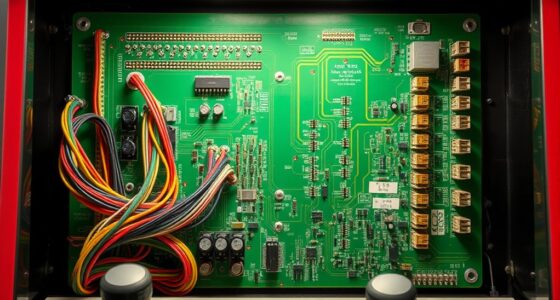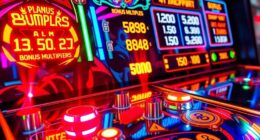Dance arcade machines track motion using advanced sensors like cameras, infrared, and LED technology to detect your movements precisely in real time. They analyze your gestures through sophisticated algorithms, calibrate to your dance style, and instantly convert your actions into game commands. These systems also process the data quickly to score your performance accurately. If you keep exploring, you’ll discover even more about how these cutting-edge technologies make gameplay smooth and immersive.
Key Takeaways
- They use sensor-based systems that interpret real-time gestures and movements for game interaction.
- Camera tracking technologies capture full-body motions using visual analysis for precise recognition.
- Infrared and LED sensors emit signals to detect subtle movements and rapid gestures accurately.
- Data processing algorithms analyze movement patterns to match predefined routines and calculate scores.
- Advances in sensors and algorithms improve motion accuracy, reducing latency and enhancing responsiveness.
Sensor-Based Motion Detection Systems

Sensor-based motion detection systems have revolutionized dance arcade machines by enabling more accurate and responsive gameplay. When you step onto the dance pad, these systems interpret your movements through gesture calibration, ensuring your motions are precisely recognized. The user interface seamlessly interacts with your gestures, providing real-time feedback and smooth gameplay. By calibrating gestures, the system adapts to your unique style, reducing errors and making gameplay more intuitive. This calibration process simplifies setup and enhances accuracy, allowing you to focus on dancing rather than troubleshooting. The sensors detect even subtle movements, translating them into game commands instantly. Overall, sensor-based systems create a more immersive experience, making dance arcade machines more engaging and accessible for players of all skill levels. Additionally, the use of local laws and resources can help optimize the calibration process to suit individual needs.
Camera Tracking Technologies
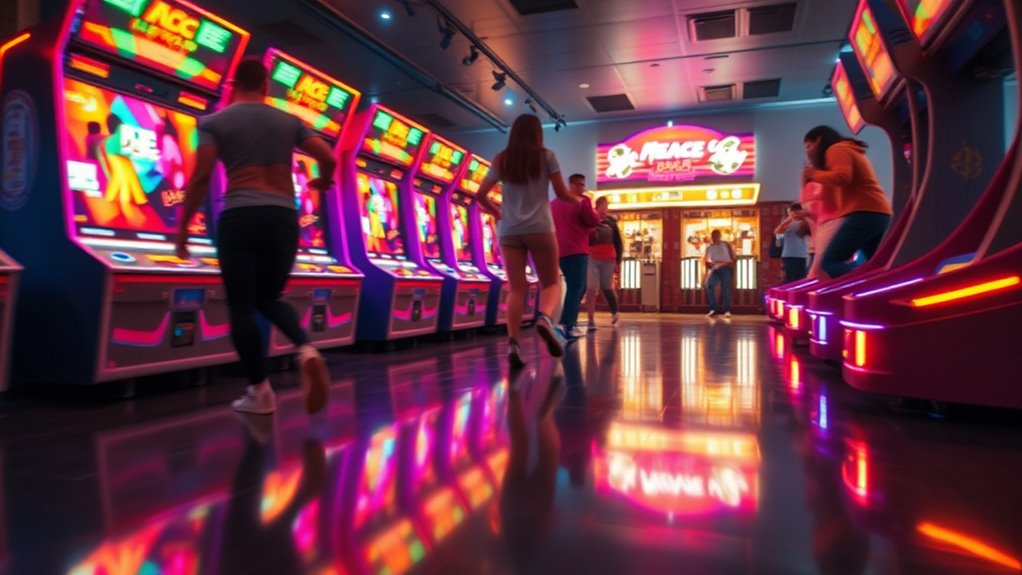
Camera tracking technologies have considerably advanced the way dance arcade machines monitor your movements by using visual data to analyze your gestures in real time. These systems rely on sophisticated cameras to capture your full-body motions, enabling precise gesture recognition. As you dance, the cameras interpret your movements instantly, translating them into game actions without the need for physical controllers. This seamless process boosts user engagement, making gameplay more immersive and intuitive. Unlike traditional sensor-based systems, camera tracking offers a broader field of view and can adapt to various body types and dance styles. By focusing on visual data, these technologies create a more natural interaction, encouraging players to express themselves freely while the machine accurately responds to every move you make. Additionally, advancements in projector technology have helped improve the clarity and responsiveness of visual data in dance arcade systems, further enhancing player experience.
Infrared and LED Sensor Integration
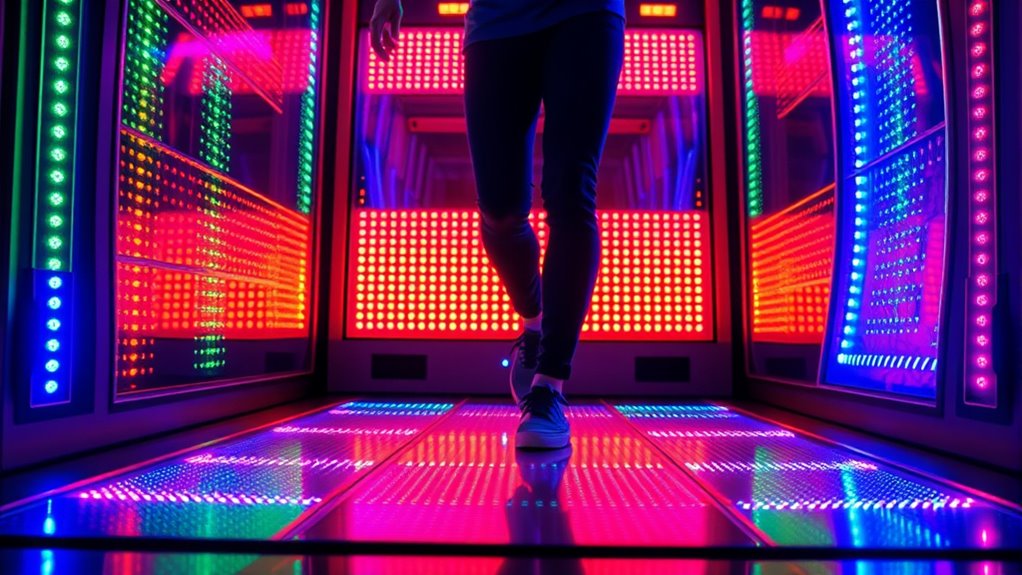
Building on the advancements in visual tracking, infrared and LED sensors add a new layer of precision to dance arcade machines. These sensors work by emitting infrared light or visible LED signals that detect your movements with high accuracy. To guarantee reliable performance, proper sensor placement is vital; positioning them at ideal angles minimizes blind spots and maximizes detection coverage. Gesture calibration is essential so the system correctly interprets your motions, reducing errors during gameplay. You’ll often need to perform calibration routines, moving in specific ways to help the sensors understand your motion patterns. This integration allows for more responsive gameplay, capturing subtle gestures and rapid movements, enhancing the overall experience. Infrared and LED sensors complement visual tracking, making dance machines more accurate and immersive.
Data Processing and Score Calculation
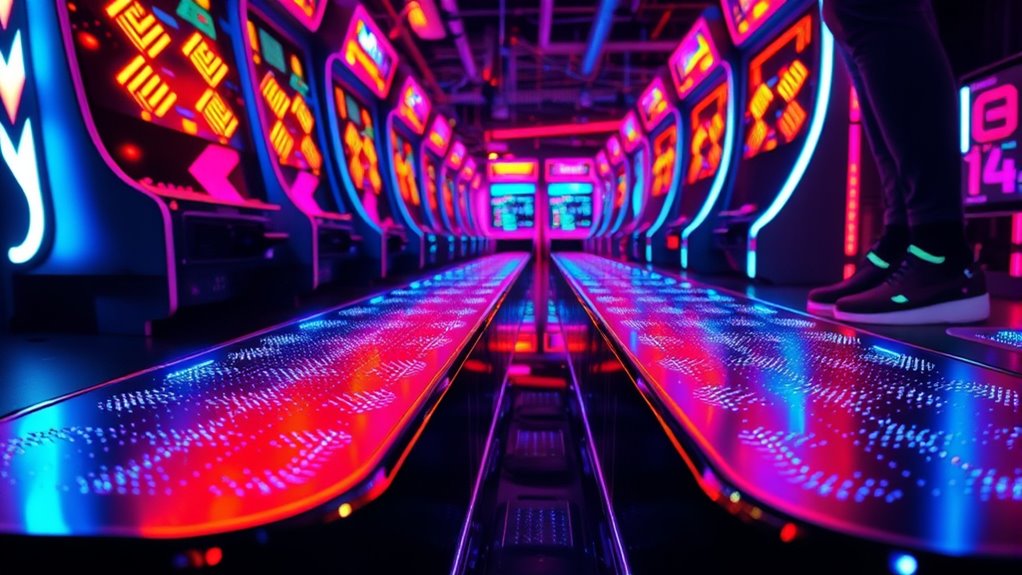
Once your movements are detected by the sensors, the system processes this data in real-time to determine your actions. Gesture recognition plays a vital role here, translating your physical motions into digital signals. The system analyzes movement patterns to identify specific gestures, such as jumps or steps, by comparing them against predefined templates. Pattern analysis helps in accurately matching your movements with the game’s expected inputs, guaranteeing precise scoring. As your actions are interpreted, the system calculates your score based on timing, accuracy, and consistency. This real-time processing ensures immediate feedback, making gameplay engaging and responsive. Efficient data processing and sophisticated pattern analysis keep the game fair and challenging, rewarding players for their skill and synchronization with the music beats. Incorporating sensor technology ensures that movement detection remains accurate and reliable throughout gameplay.
Advances in Motion Recognition and Accuracy

Recent technological breakthroughs have substantially enhanced the precision of motion recognition systems in dance arcade machines. Improved gesture calibration guarantees the machine accurately detects your movements, even in complex routines. Latency reduction minimizes delays between your actions and the game’s response, creating a more seamless experience. To visualize this, imagine a control panel with the following elements:
| Gesture Calibration | Latency Reduction | Enhanced Sensors |
|---|---|---|
| Fine-tuned detection | Instant feedback | Sensitive tech |
| Accurate tracking | Smoother gameplay | Robust hardware |
| Precise movement capture | Real-time response | Advanced algorithms |
These innovations make your dance moves feel more natural and responsive, elevating your overall gameplay. The combination of better calibration and reduced latency pushes the limits of motion accuracy in dance arcade machines.
Frequently Asked Questions
How Do Arcade Machines Differentiate Between Different Dance Moves?
You might wonder how arcade machines tell different dance moves apart. They use gesture recognition technology, which analyzes your movements to identify specific actions. Sensors are calibrated to detect precise motions, ensuring accuracy. When you perform a move, the system compares your gestures to pre-set patterns. This combination of sensor calibration and gesture recognition allows the machine to differentiate between various dance moves, making gameplay responsive and fun.
What Are Common Issues With Motion Detection Accuracy?
You might encounter issues with motion detection accuracy on dance arcade machines due to sensor calibration problems or ambient interference. If the sensors aren’t properly calibrated, they may misinterpret your movements. Additionally, environmental factors like bright lights, reflections, or other electronic devices can create ambient interference, disrupting the sensors’ ability to accurately track your dance moves. Ensuring proper calibration and minimizing interference helps improve tracking precision.
How Do Lighting Conditions Affect Sensor-Based Tracking Systems?
Lighting conditions are like a tricky dance partner, influencing how well your sensor-based system keeps in step. When ambient lighting is dim or overly bright, it can cast shadows or wash out signals, throwing off accuracy. To stay in sync, you need proper sensor calibration, ensuring your system adapts to changing light, just as a dancer adjusts to music. Bright, consistent lighting helps the sensors perform their best, capturing every move flawlessly.
Can Players Cheat or Manipulate the Motion Sensors?
You might wonder if players can cheat or manipulate motion sensors on dance arcade machines. While it’s possible, the machines use sensor calibration and cheat detection methods to prevent this. Developers constantly update these systems to spot unusual movements or patterns, making cheating difficult. So, you may try to cheat, but the machine’s advanced detection guarantees fair play and accurate tracking, keeping the game challenging and fun for everyone.
What Maintenance Is Required for Long-Term Sensor Performance?
Think of your dance arcade machine’s sensors as a garden that needs tending. Regular sensor calibration keeps the system precise, like pruning to promote healthy growth. You should also check hardware durability, ensuring components aren’t worn or damaged. Cleaning sensors gently prevents dust buildup, maintaining smooth tracking. By performing these simple maintenance steps, you’ll keep your machine’s motion sensors accurate and reliable, extending its lifespan and delivering a seamless gaming experience.
Conclusion
Now that you understand how dance arcade machines track your every move, you realize they’re like supercomputers with mind-reading powers! These systems don’t just detect motion—they anticipate your next step before you even think it. With cutting-edge sensors and lightning-fast processing, they transform your dance into a digital spectacle so precise, it’s almost like having a personal choreographer inside the machine. Get ready to dance like never before—these machines are redefining what’s possible!


